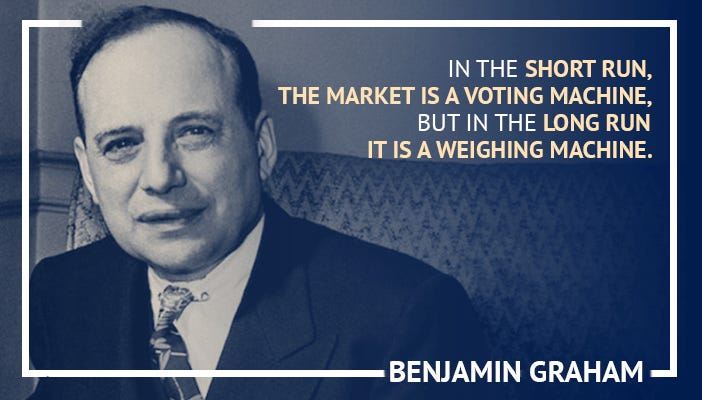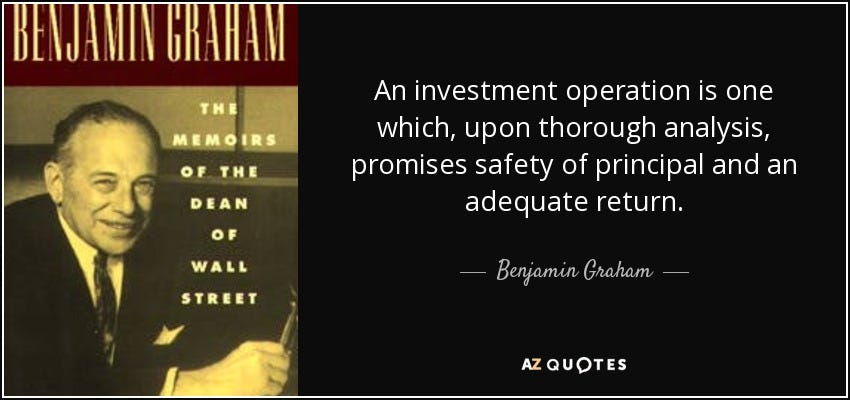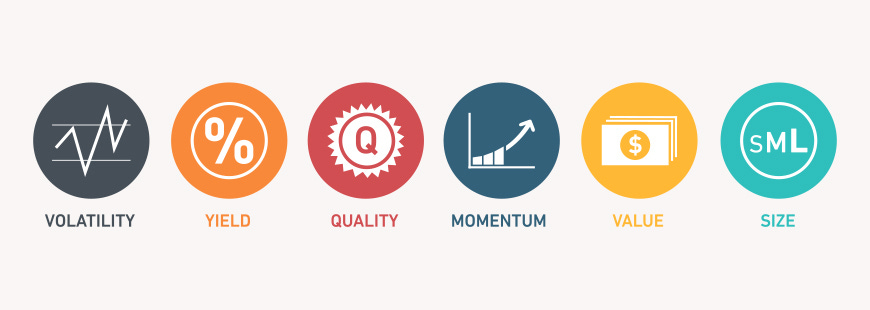Value Investors: How To "Buy & Hold" Forever Despite ST Macro Volatility
A quasi "All-Weather" Portfolio consisting of 20 Stocks (each with >1:3 asymmetric risk:reward) which can weather downside volatility from macro headwinds, designed for pure bottom-up value investors.
Chapters:
Context: Investment Objective of Classical Finance vs. Value Investing
5-Minute Elevator Pitch: The quasi “All-Weather” Value Investing Portfolio
Value Investing Portfolio: Reliable LT 15% CAGR + Low Downside Volatility (high Sortino)
Many moons ago, I wrote the article (linked above) about how value investors can create a “low-volatility value investing” portfolio. This was also my preferred approach to portfolio management when I was still managing funds in a professional capacity. However, the aforementioned portfolio management strategy required a sophisticated understanding of factor investing & macroeconomics to implement — which many pure bottom-up value investors simply do not have the time or inclination to learn.
As a result, many value investors end up adopting a volatility-agnostic approach towards portfolio management (i.e. pure bottom-up stock picking). The classic Buffett approach is what is known as the “buy and hold forever” style — where value investors identify great businesses in advance and hold them over an investment horizon of “forever”, hoping to enjoy the compounding proceeds of them constantly reinvesting their retained earnings back into the amazing business. This is great except when excessive volatility hits your portfolio — like over the past 3 years — which has shaken out many pure bottom-up stock pickers due to excessive macro volatility.
Fund managers with a classical finance background will agree that markets have become dislocated from fundamentals since excessive central bank interference waded into markets in 2008 — and that share prices have since become a function of liquidity-driven flows, rather than reflecting underlying business fundamentals. Sure, share prices can still be efficient indicators of value over a full market cycle (i.e. “buy & hold”), but they most certainly do not represent that anymore in the interim (i.e. high volatility) — the recent spike in Big Tech share prices serving as a suitable example of excessive liquidity-driven flows influenced by policymakers. Various other macro factors have also contributed to heightened market volatility, including higher participation of passive funds and deeper options market activity.
Such phenomena has led to stock markets being characterized by excessive volatility over the past decade, much to the detriment of pure bottom-up stock pickers — and reminding us of the timelessness of Benjamin Graham’s quote below:

So if you identify as a pure bottom-up stock picker, how do you navigate such excessively choppy ST volatility? In this article, I shall be providing an alternative portfolio management solution to the one which I’ve described above — designed to be much more approachable to the financial layman. It requires no advance knowledge of portfolio management or macroeconomics — even a layman can understand it, and pure bottom-up stock pickers who may prefer to stick only to identifying businesses with great fundamentals can immediately put it into practice.
If you identify as any one of the following categories of investors, you will learn how to create a Value Investing portfolio by the end of this article which:
Individual value investors — gives you adequate peace-of-mind to “buy & hold” through times of high volatility;
Professional value investors — has acceptable levels of downside volatility (i.e. Sortino ratio), thus minimizing client redemptions and forced sales when you should be buying more instead;
Stays consistently in probabilistic positive territory (i.e. high Sortino ratio) at the aggregate portfolio level;
Empirically justifies to the layman (with numerical proof) how it is capable of achieving a LT 15% CAGR using common sense — without involving sophisticated (and potentially misleading) industry jargon or mumbo-jumbo.
Gives you the courage to “be greedy when others are fearful” and practice “buy and hold forever” -style value investing with confidence!
This is how I would manage my personal portfolio if I did not possess a sophisticated understanding of institutional portfolio management strategies & macroeconomics. And it also serves as the foundation for how I plan to run my own professional portfolio one day, when I eventually start my own Value Investing-styled hedge fund.
This portfolio strategy gave me the courage to “be greedy when others are fearful” in META 0.00%↑ & NFLX 0.00%↑ close to their bottoms last year — read their theses below!
Context: Investment Objective of Classical Finance vs. Value Investing
In my view, the key difference between how practitioners of classical finance and value investing approach stock investing is this — the former is usually preoccupied with the precise forecasting of future stock price outcomes (e.g. 12m target prices); while the latter is more concerned with securing a positive distribution of all possible future stock price outcomes (i.e. risk:reward asymmetry).
Of course, it is also possible for investors to exhibit various shades of grey between the two — many classical practitioners practice value investing without even realizing it; while I personally find mixing macro considerations into my equity research useful when the circumstances call for it (i.e. not purely bottom-up investing).
The wisdom of the latter approach is best embodied in the following two quotes by two legendary value investors:


Obviously both types of investors try their utmost best to be correct about their stock analysis and forecasting of future stock price outcomes. However, the difference between the two comes to life not when they turn out to be correct in their forecasting, but when they turn out to be wrong — as alluded to in the Soros quote above.
Consider this example. A stock market practitioner of classical finance is mainly preoccupied with being correct about his forecast of future share price trajectories — but spends very little energy considering the possibility of him being wrong. Why? Well, what would be the point? If the premise assumes that the analyst is incorrect about their analysis at the outset, then their entire valuation effort is completely pointless. Thus, there is no point in even considering the possibility of the equity research analyst being incorrect — all effort should instead be channeled towards ensuring that the analyst’s forecast is as correct as possible.
From the value investor’s POV, however, this is a very real blind spot. If one simply turns a blind eye towards the possibility of being wrong, that means that the analyst could later end up being unprepared — if they later actually turn out to be wrong. Rather, the value investor considers it far more prudent to also entertain the possibility of being wrong right from the outset — and subsequently, also asks themselves what the potential outcomes of being wrong could be.
This naturally leads the value investor to consider multiple potential scenarios where he is both right and wrong about his stock forecast, to varying degrees of correctness & wrongness. Ultimately, this results in a distribution of likely possible outcomes of the future share price based on an Expected Value premise, where a particular gain/loss from the investment can be reasonably expected in a given scenario of a certain probability of occurrence — for ten broadly possible scenarios. This leads to a probabilistic “multiverse” kind of thinking of equity valuation — in stark contrast to the precise nature of target price forecasting that classical finance typically demands.
From here, the wizened fund manager will usually implement varying degrees of portfolio management in order to hedge off the correlation of the individual positions within the portfolio in order to achieve a desired portfolio risk:reward exposure. This could be as simple as trying to minimize portfolio tracking error relative to the benchmark index; or it could be as complicated as using option strategies to deliver superior risk-adjusted alpha in a bond portfolio largely composed of risk-free US Treasuries. However, such portfolio strategies usually also requires a very deep understanding of macroeconomics — such as in my aforementioned Low-Volatility Value Investing Portfolio, which relies on mutually hedging off the factor correlations of individual positions within the portfolio in order to neutralize aggregate portfolio beta, so that the fund manager can subsequently focus purely on fundamental outperformance to deliver alpha.
5-Minute Elevator Pitch: The quasi “All-Weather” Value Investing Portfolio
But what if the fundamental-only value investor exclusively wants to focus on bottom-up stock picking, instead of spending years learning how to become a macro expert before starting to manage funds? Luckily, I’ve also developed a way for value investors to achieve a “budget” version of portfolio management — which requires zero macro knowledge.
Going back to the “probabilistic distribution of future outcomes” approach as advocated by value investing above, value investors are clearly no longer merely focused on the precise forecasting of correct future target price outcomes. Rather, they are more interested in identifying all the possible paths that the future share price could take — which includes all reasonably possible upsides (i.e. reward), and all reasonably possible downsides (i.e. risk). Only when a stock opportunity presents significantly skewed asymmetry towards the upside (e.g. risk:reward of >1:3) will the value investor even consider taking a position. Until then, he is happy to sit on cash until such an opportunity presents itself (i.e. Buffett’s “no-called strike” investing).
For simplicity’s sake, let us assume that the value investor adopts a self-imposed standard to only invest in stocks with a risk:reward asymmetry of >1:3. In layman’s terms, that simply means that for every $1 he expects to lose on any position which he forecasts incorrectly, he also expects to gain $3 on any position which he forecasts correctly. This investment strategy clearly necessitates only buying stocks at ultra-low share prices relative to their underlying value, and is perhaps where the stereotypical association of value investing with net-net investing has come from (i.e. buying stocks with cheap multiples per se) — since such stocks are usually where excessive pessimism abound, and therefore where the largest spreads between price and value reside.
Now let us assume that the value investor is capable of identifying 20 stocks which each possess a risk:reward asymmetry of >1:3 — and he creates an equally-weighted diversified stock portfolio from those 20 stocks. As such, each individual position should represent a 5% weighting within his aggregate portfolio.
Let us further assume that the value investor is capable of getting at least half of his stock picks right (i.e. 10 stocks out of 20 positions). If every individual position in this portfolio sports a risk:reward asymmetry of >1:3, then there should be an average 3:1 gain/loss relationship between the correct half of the portfolio vs. the wrong half of the portfolio. Mathematically, this should result in an average gain of 200% at the aggregate portfolio level — and if the investment horizon is 5 years, a 200% return should subsequently imply a 15% portfolio CAGR.
I think that this is an extremely conservative assumption to make, since any fund manager who can’t even get at least half of his stock picks right is legitimately underperforming the baseline average. For context, most investors try to get all of their stock picks right; while most fund managers would be fired if they couldn’t even consistently achieve a hit ratio of 50%.
But is there a catch to this quasi “All-Weather” portfolio approach? Kinda.
Firstly, this portfolio strategy relies on the portfolio being diversified with at least 15-20 stocks. An otherwise insufficiently diversified portfolio would not provide the same kind of “close-one-eye” assurance that the portfolio would never suffer from excessive downside volatility (as prescribed above). To be fair, this is an exceedingly simple portfolio management strategy which is designed to be approachable to even the financial layman — so there are inevitably going to be some (acceptable) trade-offs, this being one of them. Unfortunately for the value investors who prefer Buffett’s concentrated Compounder style (e.g. 5x highest conviction stock portfolio), this approach may not be so applicable — but to be fair, this portfolio mitigates exactly the kind of client redemption risk which impacts concentrated Compounder portfolios the most.
Secondly, one has to be disciplined about staying in cash and doing nothing, until they comes across stock opportunities with a risk:reward asymmetry of >1:3. As you can imagine, such opportunities do not come by frequently — which requires the value investor to spend most of their time idling while markets froth about with activity. However, the value investor also recognizes that this portfolio approach only works when composed of stocks with such outsized risk:reward asymmetry, and therefore he disciplines himself to stay the course. Subsequently, the value investor leans into two of my favorite Buffett-isms:

Contrary to popular opinion, there is actually no trade-off involved in staying in cash until a sufficiently attractive opportunity comes along. Firstly, one only requires one good decision every five years to emulate Buffett’s success — and secondly, the stock market is a ‘no-called strike game’, where mistakes of omission are much more acceptable than mistakes of commission. In the absence of 20/20 hindsight, value investors recognizes that the more acceptable risk to take is upside risk rather than downside risk — and sticks to cash until a stock opportunity with a risk:reward asymmetry of >1:3 falls into his lap. But as long as he can do so, his pathway to a LT 15% portfolio CAGR burns neon bright.
Value Investing Portfolio: Reliable LT 15% CAGR + Low Downside Volatility (high Sortino)
But why bother with a diversified 20-stock portfolio (with all its associated tradeoffs) when a concentrated Compounders strategy is also likely to deliver a LT 15% CAGR? That’s because the former can also provide low downside portfolio volatility (i.e. high Sortino). Consider the following:
The value investing portfolio constructed as described above is likely to always stay in probabilistic positive territory at any given point in time (i.e. average max drawdown of 0%), assuming the stocks picked observe the 1:3 risk:reward asymmetry rule:
Sure, there might be one stock with a -30% drawdown at any given time; but if the investor is any good at stock picking, there’s a high chance that he’ll also have another stock in the 20-stock portfolio that is also up +30% at the same time. Even without proactive hedging of portfolio correlation, such diversification should naturally blunt overall downside volatility at the aggregate portfolio level.
Such proactive mitigation of downside volatility should result in a strong Sortino ratio at the aggregate portfolio level. This allows the pure bottom-up stock picker to reduce the risk of client redemptions or forced sales in his LT value investing portfolio at the worst possible times — during market drawdowns when he should actually be buying more or averaging down on his best ideas instead.
Having a high Sortino portfolio also makes it more marketable and commercially acceptable towards entertaining the average-down strategies that value investors are best known for, thus maximizing LT returns.
For pure bottom-up stock pickers who may not identify with sophisticated portfolio strategies, such an investment approach will still allow you to enjoy the best of both worlds in terms of stock allocation:
Firstly, you get to participate in your highest conviction ideas — even the ones which are likely to exhibit uncomfortably high volatility;
At the same time, you gain comfort from the significantly reduced downside volatility at the aggregate portfolio level — even if one particular position should swing wildly downwards. This allows you to keep a level head while considering subsequent portfolio rebalancing.
With this portfolio strategy, you gain the courage to “be greedy when others are fearful” (e.g. META and NFLX) — since each position only represents 5% of your aggregate portfolio!
For the same reason, you should have no problem implementing a “buy and hold forever” strategy, since you’re no longer overtly concerned with volatility.
Perhaps most importantly, the pathway to attaining 5-year 15% CAGR returns at the aggregate portfolio level is painted neon bright:
Assuming the bottom-up stock picker is actually capable of identifying stocks with a risk:reward asymmetry of >1:3 (and being disciplined about staying in cash unless this strict criteria is met), even the financial layman can immediately see how such a portfolio strategy can very reliably lead to a LT 15% portfolio CAGR;
i.e. If the value investor can truly identify and invest only in stocks with a risk:reward asymmetry of >1:3, he can afford to be wrong on up to half of all of his stock picks (in his 20-stock portfolio), and still achieve 15% CAGR portfolio returns over 5 years.
When the margin of safety is so excessively large (i.e. can afford to be wrong on 50% of all stock picks), achieving the investment objective becomes equally believable — it’s just common sense!
Keep in mind that we’re not talking about attaining mediocre returns here — we’re aiming for industry-leading 15% CAGR (which serves as the gold standard for professional fund managers), despite the 20-stock portfolio diversification involved. At the same time, this high-Sortino portfolio also automatically blunts downside volatility as compared to a more concentrated stock portfolio — making it significantly more emotionally palatable to both yourself and others. Best of all, the only requirement to implement such a portfolio strategy is for you to be a decent fundamental bottom-up stock picker (i.e. value investing) — no CFA Level III required!
The beauty of such a portfolio management style is that it requires absolutely zero sophisticated financial or macro knowledge to implement — which is something I believe many purely bottom-up value investors might identify strongly with and appreciate. Obviously, there is also nothing wrong with further refining this approach with macro strategies if you also possess a deep understanding of macro — but the point is that this is something that even a pure bottom-up stock picker (who excels exclusively at identifying stocks with wonderful fundamentals) can implement effectively, but which also delivers real value-add in terms of reducing portfolio volatility, and all the implied real-world benefits.
Click the button below to check out our other similar articles about Value Investing:
Share is built for long term investors. Create your own ETF, or invest in one of our premade strategies.
With Share you can:
Invest in a theme like AI 🤖 or Renewables ☀️
Copy top investors like Warren Buffett
Start with $5/week, and accumulate shares over time
Add or remove stocks at any time

















What is ST volatility?
I am stupid.
Thanks.
So how to reliably find the 1:3 stocks?